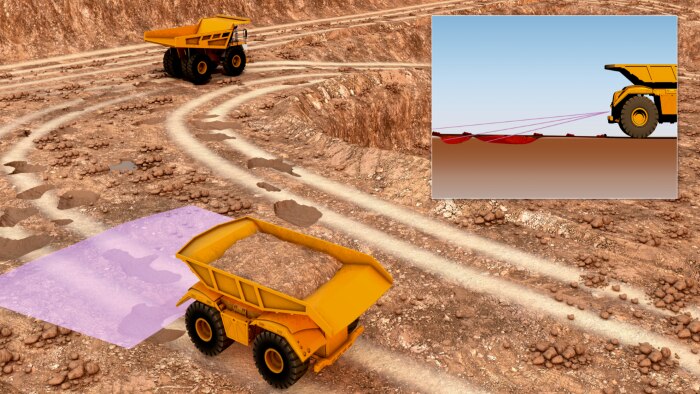Maximum functionality ignored
Production plants are quick to install smart solutions if they enable the plant to meet regulated safety standards. However, plants seldom exploit the total functionality of the solution and therefore don’t benefit from the production processing enhancement capabilities. We’ve also found that many clients don’t think they require the value-adding capabilities that form part of a solution. As a result, operators often use only 40% of a solution’s capabilities, limiting the potential for plant optimisation.
Take bund wall monitoring, which is compulsory for mines, as an example. Some mines carry out basic monitoring to tick the boxes, but don’t consider how the data gathered can be used to enhance operations. Our bund wall monitoring solution has the capacity to provide data on all site areas prone to weakness. With this information – a management tool in itself – a mine can take proactive measures to ensure existing site damage doesn’t inhibit production flow and ensure that potential future damage is limited. The data is also a guideline, providing the information necessary to install damage-preventing mechanisms at the most appropriate places, or reinforcing weakened areas so that specific occurrences do not negatively affect onsite processes. In other words, a predictive approach to the entire production process is enabled, which ultimately ensures ongoing production. All that is required is to use all available functionality inherent in these smart solutions.
Yet another example of 21st century technological capabilities used in process automation is the ability to monitor emissions. There are several automated processes that emit various gases and monitoring these emissions will soon be a legal requirement in South Africa. Many plants already have these systems in place because monitoring is a “have to”, not a “want to”. Yet sensor solutions for monitoring emissions offer a lot more than their primary focus, such as providing data to help operators understand which input adaptions might maximise process efficiency. Using all functionalities would add value in a few areas. For example, introducing an I/O Link into the system offers predictive maintenance advantages, enabling monitoring equipment to detect, ahead of time, whether process equipment is due to fail (also called ETF – estimated time to failure).
These examples reinforce the benefits of having a sensor partner who can train and upskill plant personnel to use all the features built into a sensing solution.
Factors impeding the implementation of smart solutions
It seems simple: partner with a sensor specialist to get the right system solution coupled with comprehensive training. Yet there is still slow uptake of this type of technology in the process automation sector, which may be attributable to several factors:
· Plant management
SenSensor offer a range of potential benefits (and value). But they are often used for local control only, rather than to diagnose and identify production inefficiencies. It seems there is a lack of understanding of what the technology can do and the opportunities that could be unlocked. Some plant managers lack the risk appetite to experiment with new technology. The remedy? Support from management decision-makers to take these ‘risks’.
Budgetary constraints: This type of technology is seldom part of a plant’s long-term plan and is therefore not allocated a budgeted. This is where a development budget might help. Companies willing to implement a development budget become leaders in their field. Once a client’s primary requirements are satisfied, an advanced solution can be explained and sold. The challenge is that many clients think they do not require the value-adding capabilities that form part of a solution. This re-emphasises the importance of training and upskilling plant personnel to use all the features built into a sensing solution.
Perceived high costs: Consider that an operational breakdown could cost millions in repairs and production delays. Smart sensor solutions predict possible faults and breakdowns, and prompt plant teams to take proactive remedial action. This not only optimises maintenance costs but prevents loss-making breakdowns. So, while smart technology is perceived to be costly, it is in fact an investment in efficient cost management for plant health and longevity.
Personnel turnover: The implementation of technology is a process. When personnel are replaced during this process, the replacement doesn’t always understand the value and benefits of the solution with all the bells and whistles. This has the potential to stall or end progress in any project.
Limited skills: In this context limited skills are not a result of bad or ineffective training. True skill comes from experience and from keeping up to date with technological developments. Perhaps a continuous professional development (CPD) initiative will help industry participants remain abreast of technology advancements and improve skills sector-wide.
Misperceptions of solution longevity: In some cases, the perception is that smart sensor systems will breakdown. However, some perceived ‘breakdowns’ are not breakdowns at all, but a lack of understanding of basic sensor maintenance requirements. Sometimes the solution for a ‘defective’ scanner is as simple as cleaning the scanner’s lens. This also highlights the importance of partnering with a solutions partner who provides comprehensive product training and aftersales service.
What next?
It’s clear that, without the application of smart technology, it’s difficult (and costly) to expose the ‘hidden factory’ in any processing plant. In a sector that’s increasingly competitive, with growing pressure to meet regulations for safety and environmentally sustainable operations, it’s imperative that plants refine and enhance operations to maximise production safely and sustainably.
·
Contact us here



